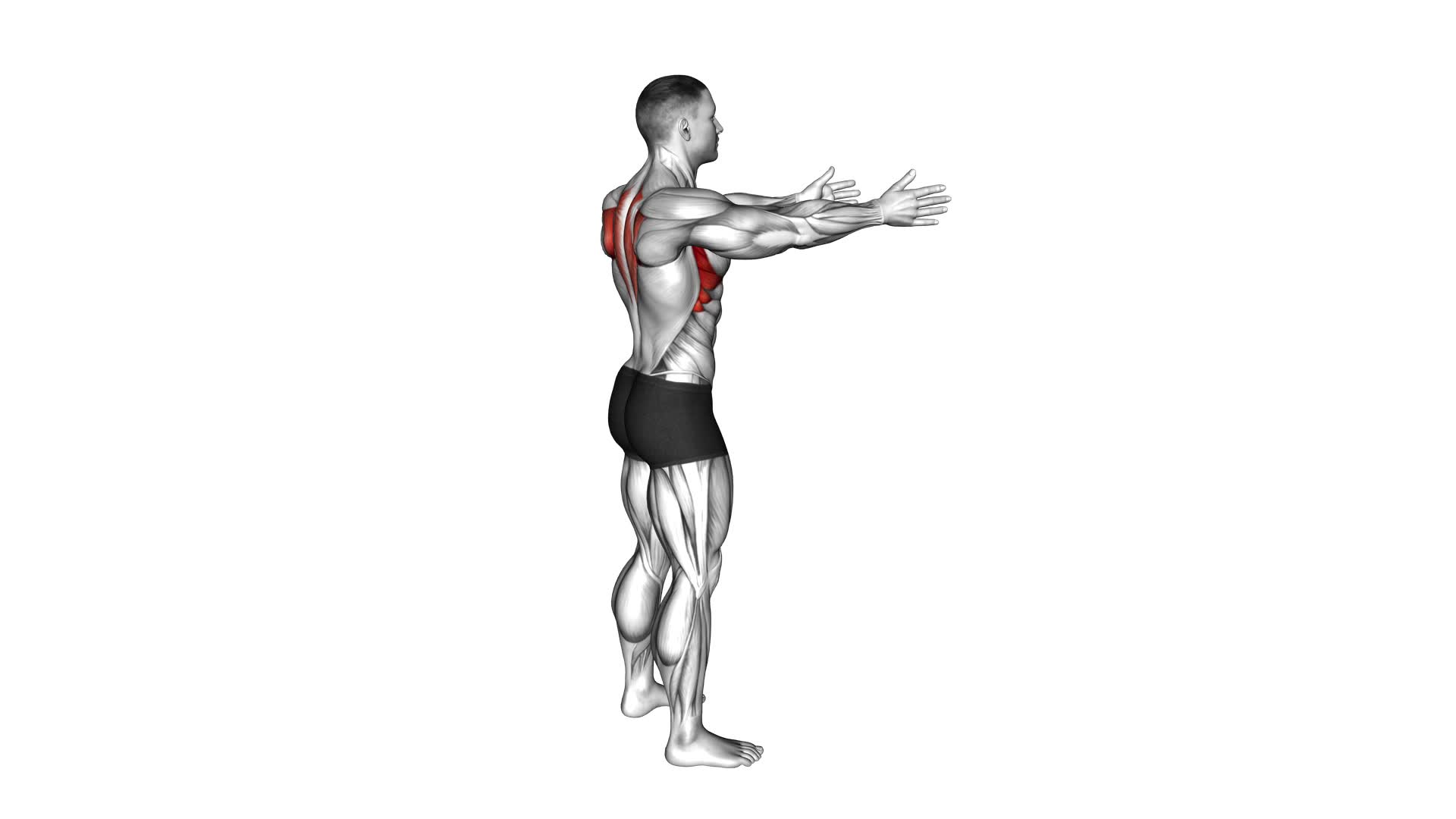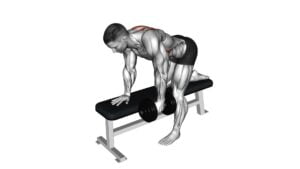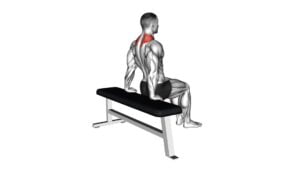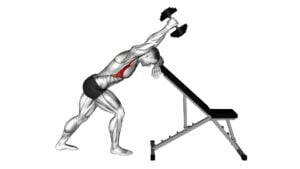Bodyweight Standing Scapula Row (male) – Video Exercise Guide & Tips

Looking to improve your upper body strength and posture? Check out this video exercise guide for the bodyweight standing scapula row (male).
Watch This Exercise Video
In just a few minutes a day, you can target your back muscles and develop better shoulder stability. No need for fancy equipment – this exercise can be done anywhere, anytime.
Watch the video for proper form and technique, and learn how to modify and progress the exercise to suit your fitness level.
Get ready to see results!
Key Takeaways
- Bodyweight Standing Scapula Row targets muscles in the upper back, improving posture and preventing shoulder rounding.
- This exercise corrects muscle imbalances caused by repetitive movements or sedentary lifestyles, enhancing shoulder stability and scapular mobility.
- It increases upper body strength and muscle definition, while also challenging core muscles and the upper body.
- Variations using resistance bands, dumbbells, or TRX straps can increase the intensity and effectiveness of the workout.
Benefits of Bodyweight Standing Scapula Row
You will experience improved posture and upper body strength when you incorporate the Bodyweight Standing Scapula Row into your workout routine. The benefits of this exercise are numerous.
Firstly, it targets the muscles in your upper back, specifically the rhomboids, trapezius, and rear deltoids. By strengthening these muscles, you can improve your posture and prevent the rounding of your shoulders. This exercise also helps to correct muscle imbalances that may occur from repetitive movements or sedentary lifestyles.
Proper form and technique are essential for maximizing the benefits of the Bodyweight Standing Scapula Row. Start by standing with your feet shoulder-width apart and your knees slightly bent. Extend your arms straight in front of you, keeping a slight bend in your elbows. Engage your core and retract your shoulder blades, pulling them back and down.
From this position, squeeze your shoulder blades together as you pull your elbows back, imagining that you're trying to touch them behind you. Pause for a moment at the top of the movement, then slowly return to the starting position.
Incorporating the Bodyweight Standing Scapula Row into your workout routine can lead to improved posture and upper body strength. It's a simple yet effective exercise that targets the muscles of your upper back.
Now, let's move on to the equipment needed for the Bodyweight Standing Scapula Row.
Equipment Needed for Bodyweight Standing Scapula Row
To perform the Bodyweight Standing Scapula Row, you'll only need your own bodyweight and no additional equipment is required. This makes it a convenient exercise that you can do anywhere, without the need for a gym or specialized equipment. Here are the main equipment needed and some variations you can try:
- Bodyweight: Your own bodyweight is the only equipment needed for this exercise. It provides the resistance necessary to engage your back muscles and improve strength and stability.
- Variations: While the basic form of the Bodyweight Standing Scapula Row requires no equipment, there are variations that can be performed using different equipment to increase the intensity and challenge your muscles further. Some variations include using resistance bands, dumbbells, or TRX straps to add resistance to the exercise.
- Resistance Bands: Using resistance bands can provide an additional challenge to the exercise by increasing the resistance as you pull against the band.
- Dumbbells: Holding a dumbbell in each hand while performing the exercise can increase the load on your back muscles and make it more challenging.
Proper Form and Technique for Bodyweight Standing Scapula Row
To perform the Bodyweight Standing Scapula Row with proper form and technique, it's important to focus on shoulder blade engagement. Keep your shoulder blades squeezed together throughout the movement to activate the muscles in your upper back.
Additionally, use muscle activation cues such as pulling your elbows back and down towards your hips to ensure proper muscle recruitment.
Be mindful of common technique mistakes such as rounding your shoulders or using momentum to complete the exercise.
Shoulder Blade Engagement
As you engage in the Bodyweight Standing Scapula Row exercise, it's important to focus on proper shoulder blade engagement. This will help improve shoulder blade mobility and enhance scapular stability.
To ensure you're engaging your shoulder blades correctly, keep the following in mind:
- Retract your shoulder blades: Squeeze your shoulder blades together as you pull your body up towards the bar.
- Avoid shrugging: Keep your shoulders down and relaxed throughout the movement.
- Maintain a neutral spine: Avoid arching or rounding your back to maintain proper alignment.
- Use controlled movements: Slowly lower your body down to the starting position to maximize the engagement of your shoulder blades.
Muscle Activation Cues
Engage your muscles properly to maximize the effectiveness of the Bodyweight Standing Scapula Row exercise. Proper muscle activation techniques are essential for targeting the right muscles and avoiding injury.
To engage your muscles effectively, start by focusing on your shoulder blades. Imagine squeezing your shoulder blades together as you pull your elbows back. This will activate your rhomboids and middle trapezius muscles.
Additionally, engage your core by pulling your belly button towards your spine and keeping your spine neutral. This will help stabilize your body and prevent excessive movement.
As you become more comfortable with the exercise, you can progress by adding variations such as using resistance bands or performing single-arm rows.
Remember to maintain proper form and technique throughout to ensure maximum muscle activation and optimal results.
Common Technique Mistakes
Avoid these three common technique mistakes to ensure proper form and technique for the Bodyweight Standing Scapula Row exercise. Maintaining correct shoulder mobility and scapular stability is crucial for maximizing the effectiveness of this exercise. Here are some common errors to watch out for:
- Rounding your shoulders: Keep your shoulders back and down throughout the movement to engage the correct muscles and prevent excessive strain on the neck and upper back.
- Using momentum: Avoid swinging your body or using momentum to complete the row. Focus on controlled and deliberate movements to target the muscles effectively.
- Neglecting full range of motion: Make sure to fully retract your shoulder blades at the top of the movement and fully extend your arms at the bottom, maintaining tension throughout.
- Poor posture: Maintain a neutral spine and avoid hunching or arching your back during the exercise.
By avoiding these mistakes, you can ensure proper form and technique for the Bodyweight Standing Scapula Row.
Now, let's explore modifications and progressions for this exercise.
Modifications and Progressions for Bodyweight Standing Scapula Row
To modify and progress the Bodyweight Standing Scapula Row exercise, you can incorporate variations that challenge different muscles in your upper body.
One modification is to use resistance bands or weights to increase the difficulty of the exercise. By attaching a resistance band to a stable object and pulling against it while performing the row, you'll engage your back muscles even more.
Another modification is to perform the exercise on an unstable surface like a Bosu ball or a balance board. This challenges your core muscles as well as your upper body.
To further progress the exercise, you can increase the range of motion by leaning back slightly as you pull your shoulder blades together. This will intensify the workout for your upper back muscles.
Lastly, you can also try performing the exercise with one arm at a time to further challenge your muscles. By incorporating these modifications and progressions, you can continue to challenge and strengthen your upper body effectively.
Now let's move on to the next section where we'll discuss common mistakes to avoid during the Bodyweight Standing Scapula Row exercise.
Common Mistakes to Avoid During Bodyweight Standing Scapula Row
When performing the Bodyweight Standing Scapula Row, be mindful of these common mistakes:
- Lack of shoulder stability: Ensure that your shoulders are stable and engaged throughout the exercise. Avoid allowing your shoulders to slump forward or round, as this can compromise the effectiveness of the movement and increase the risk of injury.
- Insufficient scapular retraction: Focus on retracting your shoulder blades as you perform the rowing motion. This helps to engage the muscles of the upper back and promotes proper posture. Avoid simply pulling with your arms, as this neglects the important scapular retraction component of the exercise.
- Using excessive momentum: Maintain control throughout the movement and avoid using momentum to complete the row. This reduces the effectiveness of the exercise and puts unnecessary strain on your joints.
- Neglecting proper form: It's crucial to maintain proper form throughout the exercise. Avoid hunching your shoulders or arching your back excessively. Engage your core and keep your spine neutral to ensure that you're performing the row correctly and safely.
Tips for Maximizing Results With Bodyweight Standing Scapula Row
To maximize your results with the Bodyweight Standing Scapula Row, focus on maintaining proper form, engaging your muscles effectively, and performing the exercise with control and precision. By following these tips, you can ensure that you're getting the most out of your workout and maximizing your results.
Firstly, it's important to maintain proper form throughout the exercise. Keep your back straight, shoulders relaxed, and chest lifted. Avoid rounding your shoulders or hunching forward, as this can decrease the effectiveness of the exercise and put strain on your neck and upper back.
Secondly, focus on engaging your muscles effectively. Imagine squeezing your shoulder blades together as you pull your arms back. This will help activate the muscles in your upper back and promote proper muscle recruitment during the exercise.
Lastly, perform the exercise with control and precision. Avoid using momentum or swinging your body to complete the movement. Instead, focus on a slow and controlled motion, making sure to fully extend your arms and squeeze your shoulder blades together at the top of the movement.
Frequently Asked Questions
How Many Repetitions Should I Do for the Bodyweight Standing Scapula Row?
To determine the number of repetitions for the bodyweight standing scapula row, consider your fitness level and goals.
Start with a moderate amount, like 8-12 reps, and gradually increase as you progress.
Avoid common mistakes by maintaining proper form and engaging your scapula muscles throughout the exercise.
Remember to listen to your body and adjust the repetitions accordingly.
Consult a fitness professional for personalized guidance on how to progress in this exercise.
Can I Perform the Bodyweight Standing Scapula Row if I Have a Shoulder Injury?
If you have a shoulder injury, it's important to modify your exercises accordingly.
The Bodyweight Standing Scapula Row may not be suitable for you in this case.
However, there are alternative scapula exercises that can be performed with a shoulder injury.
It's recommended to consult with a healthcare professional or a qualified trainer to find the best modifications and alternatives that will help you maintain your fitness goals while preventing further injury.
Is It Necessary to Warm up Before Doing the Bodyweight Standing Scapula Row?
To ensure you get the most out of the bodyweight standing scapula row, warming up beforehand is highly recommended. Proper form is crucial for this exercise, as it helps target your shoulder and back muscles effectively.
Incorporating the bodyweight standing scapula row into your workout routine offers numerous benefits, such as improving posture, strengthening the upper body, and increasing overall back stability.
Take the time to warm up properly and reap the rewards of this challenging exercise.
How Often Should I Incorporate the Bodyweight Standing Scapula Row Into My Workout Routine?
To incorporate bodyweight exercises into your workout routine, the bodyweight standing scapula row is a great choice. This exercise targets your back muscles and helps improve posture.
You can perform it 2-3 times a week to see optimal results. By adding the scapula row to your routine, you'll not only strengthen your upper body but also enhance your overall fitness.
Can I Perform the Bodyweight Standing Scapula Row if I Don't Have Access to a Bar or TRX Straps?
If you don't have access to a bar or TRX straps, there are alternative exercises you can do to work your scapula muscles.
One option is to use a resistance band and perform standing rows.
You can also try bent-over dumbbell rows or inverted rows using a sturdy table or bar.
These modifications will help you target your scapula muscles and achieve similar benefits as the bodyweight standing scapula row.
Conclusion
In conclusion, the bodyweight standing scapula row is a beneficial exercise that can be done with minimal equipment.
By maintaining proper form and avoiding common mistakes, you can maximize the results of this exercise.
Whether you're a beginner or more advanced, there are modifications and progressions available to suit your fitness level.
Incorporate this exercise into your routine to improve your scapular strength and enhance your overall upper body fitness.

Author
Years ago, the spark of my life’s passion ignited in my mind the moment I stepped into the local gym for the first time. The inaugural bead of perspiration, the initial endeavor, the very first surge of endorphins, and a sense of pride that washed over me post-workout marked the beginning of my deep-seated interest in strength sports, fitness, and sports nutrition. This very curiosity blossomed rapidly into a profound fascination, propelling me to earn a Master’s degree in Physical Education from the Academy of Physical Education in Krakow, followed by a Sports Manager diploma from the Jagiellonian University. My journey of growth led me to gain more specialized qualifications, such as being a certified personal trainer with a focus on sports dietetics, a lifeguard, and an instructor for wellness and corrective gymnastics. Theoretical knowledge paired seamlessly with practical experience, reinforcing my belief that the transformation of individuals under my guidance was also a reflection of my personal growth. This belief holds true even today. Each day, I strive to push the boundaries and explore new realms. These realms gently elevate me to greater heights. The unique combination of passion for my field and the continuous quest for growth fuels my drive to break new ground.







